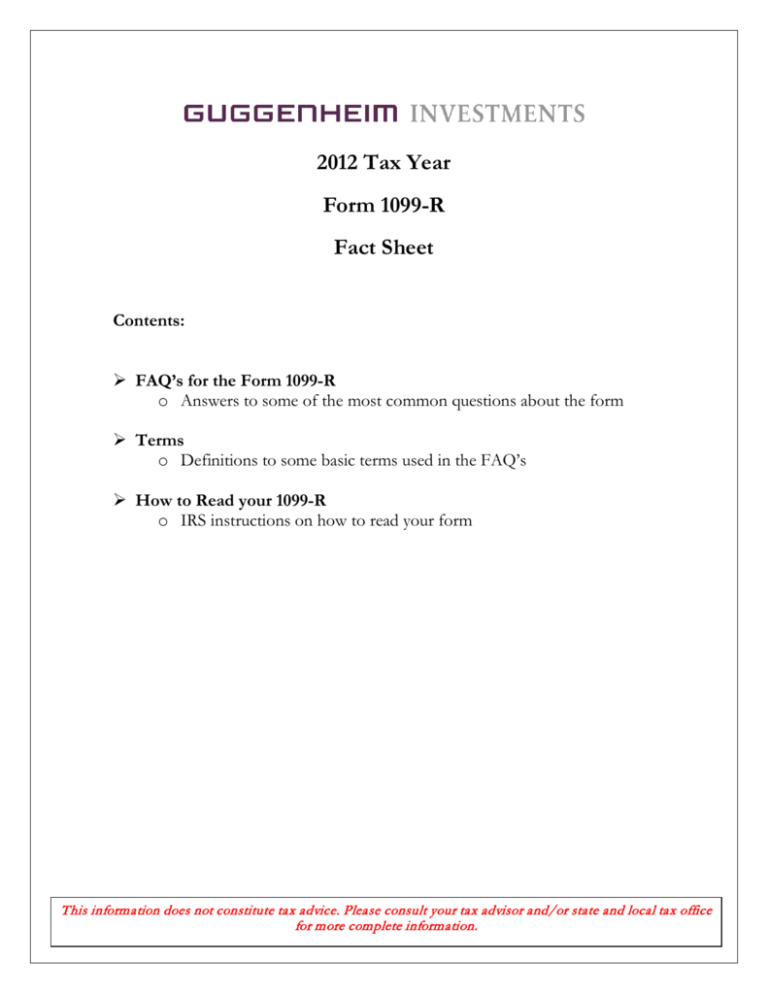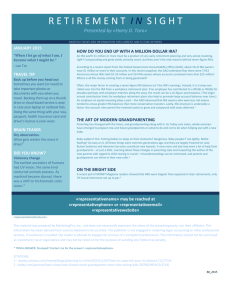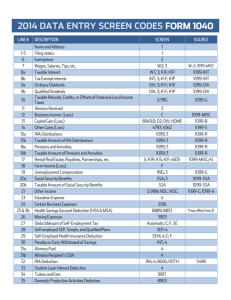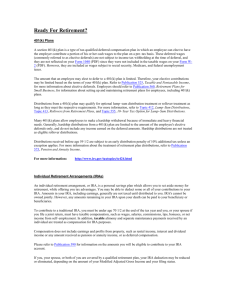Form 1099-R Fact Sheet - Guggenheim Investments
advertisement

2012 Tax Year Form 1099-R Fact Sheet Contents: FAQ’s for the Form 1099-R o Answers to some of the most common questions about the form Terms o Definitions to some basic terms used in the FAQ’s How to Read your 1099-R o IRS instructions on how to read your form This information does not constitute tax advice. Please consult your tax advisor and/or state and local tax office for more complete information. FAQ’s for Form 1099-R Q: WHAT SHOULD I DO UPON RECEIVING MY 1099-R? A: Upon receiving your 1099-R please immediately verify the following information carefully. Please report any errors immediately to facilitate the filing of corrections with the IRS in a timely manner • Social Security Number • Account Type – located next to your name o IRA = Traditional IRA o RIRA = Rollover IRA o ROTH = Roth IRA o SEP= SEP IRA o 403b = 403 b(7) Custodial Account o SIMPLE = SIMPLE IRA • Gross Distributions (box 1) and Federal income tax withheld (box 4) • Distribution Code (Box 7)- See the back of your 1099-R or the last page of this guide for code descriptions Q: WHY DID I RECEIVE A FORM 1099-R? A: Form 1099-R reports distributions taken from your IRA, Roth IRA, SEP, SIMPLE, or 403(b) account during 2012. This includes IRA distributions that were taken as a rollover. Trustee-totrustee transfers are not considered distributions and therefore are not reportable to the IRS. Q: LAST YEAR, I RECEIVED ONE FORM FOR EACH FUND BUT THIS YEAR I ONLY RECEIVED ONE 1099-R. AM I MISSING INFORMATION? A: The form you received is complete. Beginning in tax year 2012, we will report all activity in your retirement account under a single Payer ID. Q: WHY ARE MY DISTRIBUTIONS BROKEN UP ON MY 1099-R? A: If you took distributions for different reasons throughout the year, your 1099-R will list the totals for each separate code in box 7. For example, if you turned 59 ½ in 2012 and took distributions before and after your “half-birthday,” the earlier distributions will be a code “1” (Early distribution, no known exception) and the later ones will be a code “7” (Normal distribution). You may also see separate lines if distributions had different state tax withholding characteristics. Q: I MOVED MY RETIREMENT ACCOUNT FROM YOU TO ANOTHER COMPANY. WILL I GET A FORM 1099-R? A: It depends on how the money was moved. If you moved your account out of Guggenheim Investments as a rollover then you will receive a 1099-R. If you moved the money by completing a trustee-to- trustee transfer then you will not receive a 1099-R. (See definitions on the following page.) This information does not constitute tax advice. Please consult your tax advisor and/or state and local tax office for more complete information. Q: WHY ARE YOU NOT ABLE TO DETERMINE MY TAXABLE AMOUNT? A: IRA owners are ultimately responsible for determining the taxable amount of their distribution(s). We may not be aware of all of the factors affecting the taxable amount. Q: WHAT DOES THE NUMBER OR LETTER LISTED IN BOX 7, DISTRIBUTION CODE, REPRESENT? A: These codes identify the type of distribution taken from your retirement account. For a list of commonly seen codes on the Form 1099-R, see the included table or the table on the back of your 1099-R. Q: WHAT DO I DO IF I HAVE QUESTIONS ABOUT THE INFORMATION ON MY 1099R? A: Please contact Guggenheim Investments Client Services at 800.820.0888, Monday through Friday, 8:30 am - 5:30 pm, ET to speak with one of our representatives. Terms: Rollover: An individual who intends to roll over IRA funds is actually taking a distribution from his or her IRA. If the distributed funds are not deposited into an IRA within 60 days, the individual will be subject to taxation and penalties. A distribution, even if it is intended to be a rollover, is reported on Form 1099-R. Upon completing the rollover, the new IRA custodian reports the rollover deposit on IRS Form 5498 (issued by May 31 each year). Successfully completed rollovers are generally taxfree but must be reported on the individual's tax return. Individuals may make only 1 rollover every 12 months (NOT calendar year). Trustee-to-trustee Transfer: This type of transfer is a way of moving money directly; tax-free, from one IRA to another. The IRA holder does not actually take control of the funds when conducting a transfer. The distributing and receiving financial organizations generally handle the transactions. Transfers are not considered distributions and therefore are not taxable and are not reported to the IRS. Individuals may make an unlimited number of transfers per year. This information does not constitute tax advice. Please consult your tax advisor and/or state and local tax office for more complete information. How to Read Form 1099-R Instructions for Recipient Generally, distributions from pensions, annuities, profit-sharing and retirement plans (including section 457 state and local government plans), IRAs, insurance contracts, etc., are reported to recipients on Form 1099-R. IRAs. For distributions from a traditional individual retirement arrangement (IRA), simplified employee pension (SEP), or savings incentive match plan for employees (SIMPLE), generally the payer is not required to compute the taxable amount. See the Form 1040 or 1040A instructions to determine the taxable amount. If you are at least age 70½, you must take minimum distributions from your IRA (other than a Roth IRA). If you do not, you may be subject to a 50% excise tax on the amount that should have been distributed. See Pub. 590 for more information on IRAs. Roth IRAs. For distributions from a Roth IRA, generally the payer is not required to compute the taxable amount. You must compute any taxable amount on Form 8606. An amount shown in box 2a may be taxable earnings on an excess contribution. Box 1. Shows the total amount you received this year. The amount may have been a direct rollover, a transfer or conversion to a Roth IRA, a recharacterized IRA contribution; or you may have received it as periodic payments, as non-periodic payments, or as a total distribution. Report the amount on Form 1040 or 1040A on the line for “IRA distributions” or “Pensions and annuities” (or the line for “Taxable amount”), and on Form 8606, as applicable. However, if this is a lump-sum distribution, see Form 4972. If you have not reached minimum retirement age, report your disability payments on the line for “Wages, salaries, tips, etc.” on your tax return. Also report on that line permissible withdrawals from eligible automatic contribution arrangements and corrective distributions of excess deferrals, excess contributions, or excess aggregate contributions except if you are self-employed. Box 2a. This part of the distribution is generally taxable. If there is no entry in this box, the payer may not have all the facts needed to figure the taxable amount. In that case, the first box in box 2b should indicate “Yes”. You may want to get one of the free publications from the IRS to help you figure the taxable amount. See Additional information below. For an IRA distribution, see IRAs and Roth IRAs on this page. For a direct rollover, other than from a qualified plan to a Roth IRA, zero should be shown, and you must enter zero (-0-) on the “Taxable amount” line of your tax return. If this is a total distribution from a qualified plan and you were born before January 2, 1936 (or you are the beneficiary of someone born before January 2, 1936), you may be eligible for the 10-year tax option. See the Form 4972 instructions for more information. If you are an eligible retired public safety officer who elected to exclude from income distributions from your eligible plan used to pay certain insurance premiums, the amount shown in box 2a has not been reduced by the exclusion amount. See the instructions for Form 1040 or Form 1040A for more information. Box 2b. If the Taxable Amount Not Determined box indicates “Yes”, the payer was unable to determine the taxable amount, and box 2a should be blank, except for an IRA. If the Total Distribution box indicates “Yes”, the distribution was a total distribution that closed out your entire account. Box 4. Shows federal income tax withheld. Include this amount on your income tax return as tax withheld, and if box 4 shows an amount (other than zero), attach Copy B to your return. Generally, if you will receive payments next year that are not eligible rollover distributions, you can change your withholding or elect not to have income tax withheld by giving the payer Form W-4P. Box 7. The following codes identify the distribution you received. For more information on these distributions, see the instructions for your tax return. Also, certain distributions may be subject to an additional 10% tax. See the instructions for Forms 5329 and 8606. 1—Early distribution, no known exception (in most cases, under age 59½). 2—Early distribution, exception applies (under age 59½). 3—Disability. 4—Death. 7—Normal distribution. 8—Excess contributions plus earnings/excess deferrals (and/or earnings) taxable in 2012. B—Designated Roth account distribution. G—Direct rollover of a distribution (other than a designated Roth account distribution) to a qualified plan, a section 403(b) plan, a governmental section 457(b) plan, or an IRA. H—Direct rollover of a designated Roth account distribution to a Roth IRA. J—Early distribution from a Roth IRA, no known exception (in most cases, under age 59½). N—Recharacterized IRA contribution made for 2012 and recharacterized in 2012. P—Excess contributions plus earnings/excess deferrals (and/or earnings) taxable in 2011. Q—Qualified distribution from a Roth IRA. R—Recharacterized IRA contribution made for 2011 and recharacterized in 2012. S—Early distribution from a SIMPLE IRA in first 2 years, no known exception (under age 59½). T—Roth IRA distribution, exception applies. If the IRA/SEP/SIMPLE box indicates “Yes”, you have received a traditional IRA, SEP, or SIMPLE distribution. Boxes 12—13. If state or local income tax was withheld from the distribution, these boxes display the state tax that was withheld and our state tax ID number. Additional information. You may want to see: Form W-4P, Withholding Certificate for Pension or Annuity Payments, Form 4972, Tax on Lump-Sum Distributions, Form 5329, Additional Taxes on Qualified Plans (Including IRAs) and Other Tax-Favored Accounts, Form 8606, Nondeductible IRAs, Pub. 560, Retirement Plans for Small Business (SEP, SIMPLE, and Qualified Plans), Pub. 571, Tax-Sheltered Annuity Plans (403(b) Plans), Pub. 575, Pension and Annuity Income, Pub. 590, Individual Retirement Arrangements (IRAs), Pub. 721, Tax Guide to U.S. Civil Service Retirement Benefits, Pub. 939, General Rule for Pensions and Annuities. This information does not constitute tax advice. Please consult your tax advisor and/or state and local tax office for more complete information.





